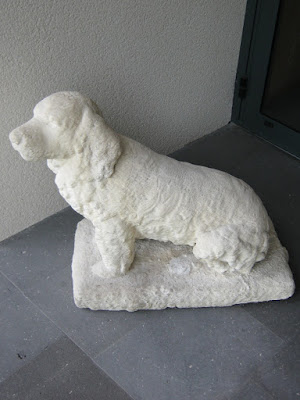Wednesday 21st September, St. Nectaire, Auvergne
Today we have been making our way south west through the volcanic mountains of the Auvergne. Lunchtime saw us on the edge of Volvic which we visited many years ago, long before we were joined by Modestine. Then we spent the night there and reflected that we were actually showering in Volvic! The water comes up into the streets through fountains and runs down the gutters to clean them.
Today we arrived at lunch-time and the town was silent as we wandered the streets. Volcanic stone has been used extensively in the town which looks rather dark and forbidding as a result. Nowadays the dark grey/black basalt stone is mainly used for decorative facings around doors and windows. It is though a fine volcanic stone without large and obvious bubbles. It has been used as a base stone for enamel work and we chanced on a gallery displaying some rather fine examples. There were also several shops displaying enamelled signs signifying their trade, such as the baker with his bread oven.
During the afternoon we stopped for a picnic lunch by yet another pretty river as it passed through the village of Pontgibaud. Later we passed near the Puy-de-Dôme with its distinctive shape and transmitter on the summit.
We are currently camped above the little town of St. Nectaire, famed for its cheese of the same name. Earlier this afternoon we stopped to explore the deserted volcanic spa town of Murol. The main hotel is boarded up and for sale, the season is over and quite honestly, what is there to do in some of these little spa towns? Their heyday has long passed.
Friday 23rd September, Langogne, Languedoc-Roussion
Yesterday we spent a warm and sunny morning around St. Nectaire with its charming, southern French romaneque church built on a pinnacle at the top of the town. Constructed from volcanic stone from the surrounding mountains of the Parc national des Volcans in the 12th century it is one of the most lovely churches we have seen. It blends totally with the landscape with different coloured stone being used to create patterns on the walls of the apse with its Romanesque arches behind the altar. We have described St. Nectaire on our previous visit to this area.
Down in the valley we discovered the casino set amidst the seven different spars offering cures and wellness treatments. Large descriptive panels lead us around attractively landscaped parkland taking in the seven stations of the spas. One spa was rather like that of Mother Shipton in Yorkshire. Stay still long enough and you will be transformed into a pillar of salt. People bring their dogs (after they have died) and take them home again petrified in white salt to use as a door stop for ever!
Realising we were not far from Issoire and having happy memories of visiting Joël’s and Danielle’s son Stephane and his family there many years ago when he was stationed there with the French army, we drove over for a nostalgic stroll through the vaguely familiar streets and to feed Modestine with a hearty lunch of diesel.
Issoire also has a lovely 12th century church, a fitting partner for that in St. Nectaire. Again it is built in volcanic stone, beautifully patterned externally with carvings of the zodiac around the apse. Inside, the capitals and columns have all been decorated in bright paints. This picks out the details of the scenes on the capitals and the flowers and tendrils on the columns add colour to the interior. Down in the crypt the 13th century enamelled coffer purchased to house the relics of Issoire’s patron saint, St. Austremoine, is on display along with a colourful account of its disappearance for several decades before it turned up somewhere in New Zealand. (We have written previously about Issoire.)
After that the rest of the day was not very pleasant, consisting of constant driving in burning sunshine and in heavy traffic that went too fast for single carriageway roads, where drivers are impatient and desperate to overtake. Eventually we could turn off from the route nationale and wind our way at a leisurely pace through lovely countryside and woodland where we saw not a soul or vehicle for miles. They were all rushing across France on the routes nationales! We camped overnight on a quiet site with a heated shower room. Temperatures dropped down to 3 degrees overnight. Suddenly autumn has arrived. Leaves are whirling down and we have needed to unearth our extra blanket. Just a week ago daytime temperatures touched 40 degrees Celsius. Last night they dropped by 37 degrees! Today though, after a chilly start, by lunchtime we were into the mid 30s again.















